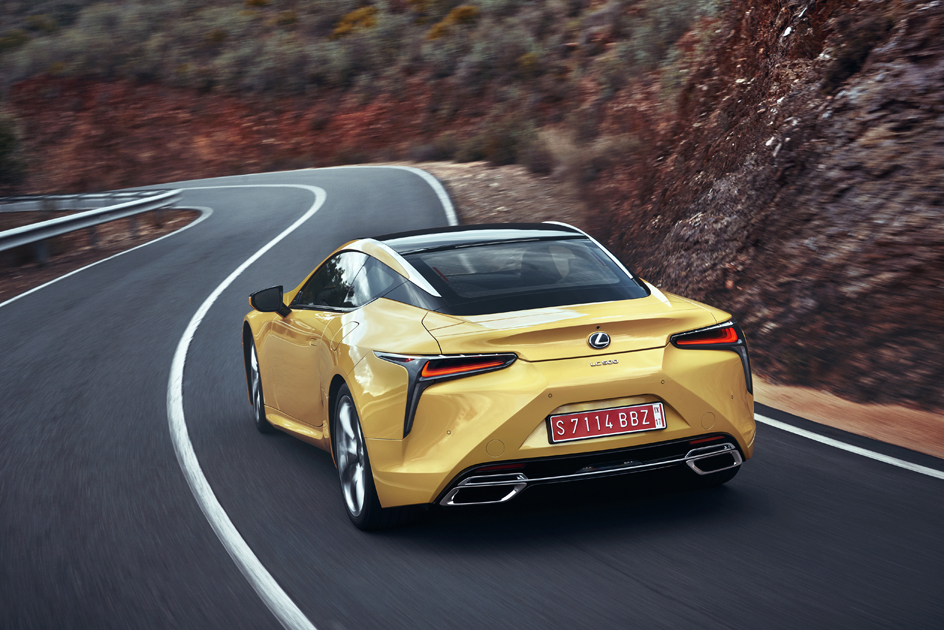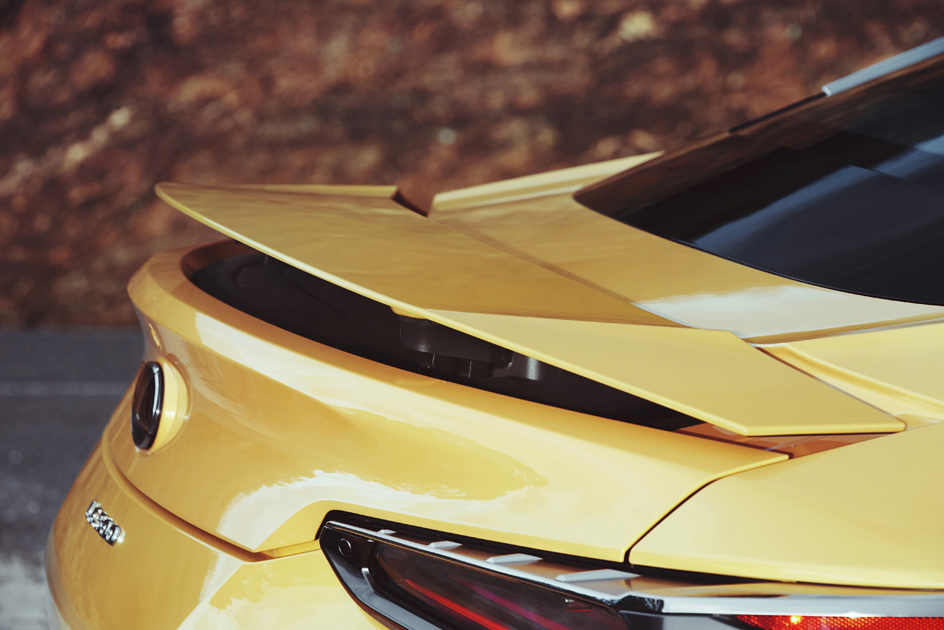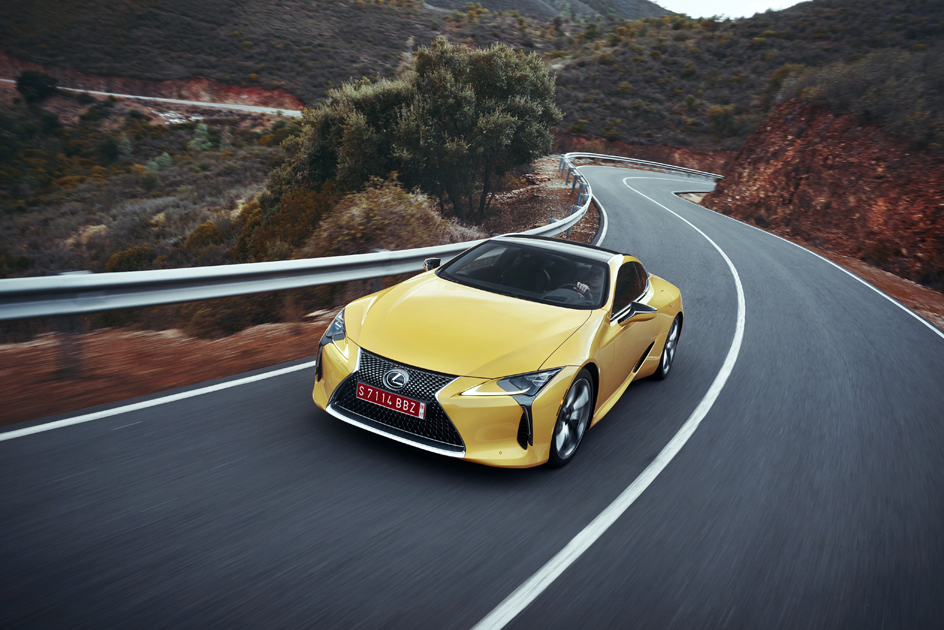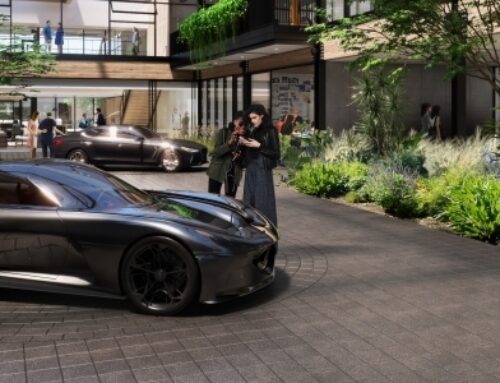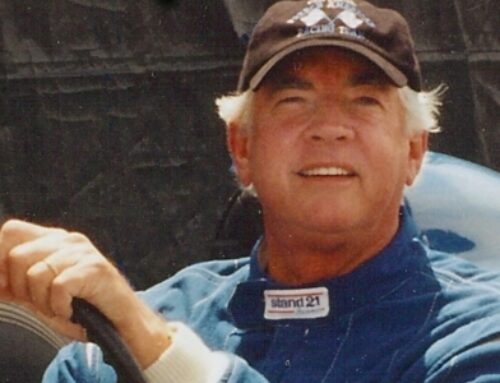The introduction of the new LC performance coupe is a significant illustration of Lexus’ dedication to create cars with exciting, emotional designs and exhilarating performance.
In the space of just 27 years, Lexus has had a transformative effect on the world’s luxury car market. Engineering excellence has produced generations of powerful, responsive engines and transmissions, while its pioneering hybrid technology has taken efficiency and smoothness to ever-higher levels. Cutting-edge design and a contemporary approach to luxury based on master craftsmanship traditions further emphasize its status as a world-class luxury vehicle manufacturer.
Now Lexus is building on its established strengths and evolving its reputation for vehicle development to explore new opportunities in design and technology that reshape its model range.
The change is being led from the top by Akio Toyoda, who in taking on the roles of Lexus’ Chief Branding Officer and master driver, has given the business more freedom, autonomy, and the confidence to be daring. With the benefit of dedicated resources, greater flexibility and quicker decision-making, Lexus has delivered a succession of vibrant new models that are changing the way it is perceived by both customers and the global automotive industry.
Lexus has succeeded in turning its LF-LC concept into an uncompromised production car, in less than five years since its unveiling to huge critical and public acclaim. This feat has called for new ways of cooperation between the design and engineering teams throughout the development process.
A FLAGSHIP COUPE
The LC is a new flagship 2+2 performance coupe for Lexus’ global model range, not only showcasing the qualities of design, beauty, engineering and advanced technology that define it as a premium vehicle manufacturer, but also symbolizing its ambition as a luxury lifestyle brand. The Lexus LC will go on sale in the U.S. in Spring 2017.
The LC isn’t simply a car that looks good. It has been engineered in every dimension to deliver a very special driving experience. “Even sharper and more refined” were the constant watchwords as Lexus honed every aspect of the car’s performance, ride and handling. It is a contemporary interpretation of the finest traditions of the grand tourer, a coupe focused on the road, not the track. Its handling, responsiveness and comfort have been tuned to deliver a rewarding and hugely enjoyable experience.
DYNAMIC COUPE DESIGN
The LC’s exterior design is immediately recognizable as being a masterful reinterpretation of the styling of the LF-LC concept, winner of an EyesOn Design award when first revealed at the 2012 North American International Auto Show (NAIAS) in Detroit.
Making the show car’s styling a practical proposition for a full production car required a new way of working at Lexus, bringing the engineering and design teams together with an unprecedented degree of cooperation to achieve the desired results, with hard work fueled by a shared desire to make the LC a success, without compromise. At the same time as the challenge of the exterior design was taken, a new cabin was created, combining a driver-focused cockpit with an open and welcoming space for passengers.
The success of this team was proven when the LC won two additional EyesOn Design awards when it was revealed at the 2016 North American International Auto Show (NAIAS).
An unprecedented design challenge
The delivery of such uncompromised styling was at the heart of the project led by Chief Engineer, Koji Sato, and Chief Designer, Tadao Mori. Their work was inspired by the hugely positive media and public reception for the LF-LC and the personal support of Akio Toyoda, who saw the concept as a route to introducing more emotion into the Lexus brand.
Translating the styling of the 2012 LF-LC concept into a viable production model was a complex challenge, considered by Sato as the greatest Lexus had undertaken since the development of the original LS. Its successful achievement called for new ways of collaboration between the engineering and design teams right from the start.
Sato explains: “While maximizing the fundamental taste of the LF-LC, we applied completely different specifications to create a design that goes beyond the concept—a design that will captivate you as soon as you see it. In my view, pursuing beautiful design and elaborating great performance is very similar. Beauty is the identity of Lexus’ design. Every feature on the LC is the result of an integrated approach to design and engineering. All the teams worked together—engineers and designers alike. This is why we have been able to create such a great car.”
New Global Architecture – Luxury platform
The desire was to preserve the LF-LC’s defining low roof and hood lines, while ensuring the packaging allowed the LC to match the concept in accommodating a sport suspension and 21-inch forged alloy wheels. At the same time, all powertrain, chassis and safety components had to be housed and comfortable headroom had to be provided in the cabin. The teams had the benefit of working on a completely new GA-L (Global Architecture – Luxury) platform, designed for new generations of front engine/rear-wheel drive Lexus models.
As an example of the teams’ commitment to success, the front suspension components went through six months of re-working the multilink suspension control arm geometry until the required low hood line was achieved, without compromising suspension performance. Other clever solutions were developed, such as the new ultra-slim LED headlight unit design, which allowed the LC to retain exceptionally short front overhangs.
EXTERIOR: AVANT GARDE ELEGANCE
The LC displays performance coupe proportions with an exterior design that projects an avant-garde elegance, remaining faithful to many of the defining features of the LF-LC concept car that inspired it. The design wraps the car in a glamorous body that represents an evocative and fluid interpretation of Lexus’ “seduction and technology” design theme.
Athletic profile
The coupe’s athletic profile is characterized by its sweeping roofline, which tapers rearward from above the centrally positioned cabin to create a distinctive silhouette. Chrome-plated moldings along the side of the glass roof amplify the elegant coupe profile, their rear edges shaped to echo the lines of a traditional Japanese sword. The blacked-out finish to the roof and rear pillars creates a floating effect that visually separates the roof from the rear spoiler.
The LC’s appearance can be made even more dynamic with the addition of an optional Carbon Fiber Reinforced Plastic composite roof and active rear spoiler.
The LC has a 2,870mm (112.99 in.) wheelbase and—in a direct reference to the styling of the LF-LC— very compact overhangs (920mm/36.22 in. front, 970mm/38.19 in. rear) and a notably low hood line.
The prominent front and rear spoilers flare away from the center of the car, housing wide, large-diameter wheels, while the door panels are pulled inwards, creating a powerful three-dimensional form that mirrors the spindle shape of the Lexus grille.
The LC can be outfitted with 20-inch cast aluminum or available 20 and 21-inch forged aluminum alloy wheels.
Front design
The spindle grille itself – a hallmark of Lexus design – is finished in chrome and has an arresting new mesh design with visual tension that changes as it spreads across the front of the car. The unique LC lighting signature is created by independent daytime running lights in an arrowhead configuration and ultra-compact triple LED headlamp units. Achieving this remarkably slim headlight design played an important role in helping the designers achieve the coupe’s low hood and short front overhang.
Rear styling
At the rear the roof tapers down between muscular wheel arches, reinforcing the car’s wide and stable stance. The Lexus spindle shape is visible here in a three-dimensional form that is generated by lines flowing from the front of the car and along the sides, before cutting back around the inner edge of the rear combination lamps. The line of the spindle then moves outwards, following the shape of the license plate mounting and outer edges of the tailpipes.
The rear combination lamps, set vertically at the outermost edge of the bumper, have a graphic that guides the eye in three directions, accentuating the flow along sides of the body and emphasizing the vehicle’s strong, planted look. The use of several different materials in the lens and bezel provide a further indication of the sophisticated workmanship invested in the LC. Within the combination units, the taillights feature a new Lexus concept, using mirrors to create a multi-reflection, three-dimensional sequence of L-shaped graphics.
AERODYNAMICS
As much as Lexus sought to carry forward the sensuous styling of the LF-LC concept into the production LC, it also worked to introduce a high level of aerodynamic performance to enhance the coupe’s handling and ride quality while suppressing wind noise.
The aim was to achieve a smooth, unbroken front-to-rear airflow both over and beneath the body. Design elements that help control and direct the airflow include small but critical aero stabilizing fins on the front pillars, just forward of the door mirrors. Just a 5mm difference in their size or position can affect the car’s handling and level of wind noise.
An available active rear spoiler is automatically deployed when vehicle speed rises above 80km/h (50 mph). This suppresses lift at the rear to help provide a high degree of stability when driving at speed.
Aero ducts are featured just forward of the rear wheel arches, serving a highly practical function as well as contributing to the dynamic power of the LC’s styling. These feed air into the wheel arch, which then exits smoothly across the sidewall of the tire. This contributes to the car’s high-speed straight-line stability and steering responsiveness and generates an enhanced grip feel from the rear tires, for example when changing lanes.
The treatment of the underbody has been given equally close attention, with an almost completely smooth finish. Parts are aligned with the aero line, which kicks up towards the rear – notably the silencer is angled upwards, like a diffuser.
DYNAMIC LUXURY INTERIOR
The dynamic luxury theme of the exterior is carried through into the LC’s 2+2 cabin. This space is designed to provide sophistication and intricate attention to detail with a driver-focused cockpit.
Cabin design
The area around the front passenger spreads outwards to create a comfortable and welcoming space. In fact, the flowing line of the door trim is an extension of an exterior line that flows from the hood and through the windscreen, building a sense of continuity between the outside and inside of the car.
The driver’s cockpit has been ergonomically designed to instill confidence and invite spirited driving, with an intuitive layout of the controls and an excellent seating position. The driver’s hip point has been located as close as possible to the coupe’s center of gravity, maximizing direct feedback of the vehicle’s dynamic performance. The driver also enjoys an excellent view of the road, uncompromised by the low seating position thanks to the low hood line, the low-profile instrument panel and the location and narrow width of the front pillars. The shallow height of the instrument panel has been helped by the development of compact air vents.
Ease of access
Lexus has ensured getting in and out of the LC is easy and comfortable by providing generous legroom beneath the instrument panel, reducing the height difference between the rocker panel and the vehicle floor, and enlarging the door aperture to provide comfortable head space.
Steering wheel and controls
Particular attention has been paid to the steering wheel design, with a change in the cross-section around its circumference to allow for variations in grip and twisting of the wrist. New, larger magnesium alloy paddle shifters allow for easier hooking with the fingertips and a substantial feel when used.
The instrument panel has a taut and rigid frame that creates a strong horizontal axis. All the principal instrumentation and function controls are contained within its cross-section.
The information displays are arranged in order of importance, with the most critical positioned closest to the driver’s sightline, within the dashboard’s upper display zone. All are positioned at the same height, to reduce the degree of eye movement required for the driver to read them. The instrument binnacle houses the latest development of the thin film transistor (TFT) meter technology introduced in the Lexus LFA supercar, including a moving central ring.
Driving-related switches and controls are arrayed in a control zone that is concentrated immediately around the steering wheel. These include the paddle shifters, steering wheel combination switches, Drive Mode Select switch, starter button and shift lever. The center console features the latest-generation Remote Touch Interface touchpad control, with quick and intuitive operation.
Throughout the cabin the quality and finish of the upholstery, trim materials and detailing reflect the Takumi craftsmanship and fine attention to detail for which Lexus is renowned worldwide. It can be witnessed in the hand-stitching of the leather-wrapped gearshift lever, the draping treatment of the Alcantara door panel trims, and the discreet use of the Lexus “L” motif in areas such as the face of the analog clock and the tactile raised surfaces of the air vent controls.
Seat design
Providing the driver with a seat with the best possible combination of support and comfort was a focus point in the development of the LC’s cabin. Chief Engineer Sato himself was involved in the process for developing a new design that went through an exhaustive 50 test cycles.
The aim was to deliver an advanced design with excellent holding performance and superb comfort. Lexus has achieved this with a new two-part construction technique in which the main part of the seatback drapes over the shoulder area of the seat and wraps around the back. To ensure superior lateral support, additional bolstering is provided for the driver’s shoulder blade area, and resin inserts enhance the holding performance of the side bolsters. On the available sports seats, the bolsters are even more substantial, with a focus on keeping the driver’s back in place in high-speed cornering.
The seat cushion has been shaped to ensure excellent support for the pelvis, so that pressure is evenly distributed to the front and back.
Interior colors
Available interior color schemes for the LC include new Bespoke White and Mid Brown shades, together with Lexus’ established Rioja Red and Black finishes. The color options and combinations allow customers to create a distinctive and individual cabin that projects a sporty or luxurious look.
The Bespoke White color is exclusive to the LC, combining a mid-blue finish for the upper door trims, steering wheel, instrument panel and center armrest with contrasting white seat upholstery and vivid orange for the door panels and shift lever surround. The Mid Brown option provides a monotone finish throughout the interior in warm harmonizing shades of brown, producing a highly luxurious effect.
INTERIOR FINISHING
Here the skills of the Takumi can be seen in precise stitching that maintains a flawless finish where leather spreads across complex surfaces. The draping effect of the Alcantara in the door panels and the arrangement of the perforations in the leather seat upholstery are further hallmarks of the attention to detail invested in creating a perfect cabin environment.
The shape and feel of the steering wheel – a critical link in communicating the quality of the LC’s performance to the driver – were defined through hours of testing and re-testing by a Takumi master driver. His exhaustive analysis produced a highly complex cross-section design. The profile for each section of the wheel produces the ideal shape to suit the driver’s changing grip and hand position as they steer. The same process was applied to developing the shape and action of the paddle shifters for manual gear selection. Crafted in cool-to-the-touch magnesium alloy, they have a finely defined profile for ease of use and they operate with a satisfying click-response.
HAND-CRAFTED GEAR SHIFT KNOB
The construction and finishing of the gear shift knob exemplifies the craftsmanship and attention to detail that is invested throughout the vehicle. Great efforts have been invested in ensuring this highly tactile part conveys the level of quality that can only be delivered by skilled craftspeople.
The knob is leather-wrapped, in keeping with the extensive use of fine leather in the LC’s cabin, created using an in-stitch method that keeps the stitching concealed. The seams are straight thanks entirely to the advanced skills of the Lexus craftspeople (the sewing margin is just 2mm (0.08 in), while the size and shape of the stitch holes, the thickness of the needle and the angle of the needles are all subject to constant checks to ensure perfect consistency.
The metal parts are slightly recessed, so the palm of the driver’s hand feels only the leather surface when using the shift lever. Different parts of the knob have contrasting tactile qualities: the top is smooth and soft, with a urethane sheet adding a degree of flexibility, while the perforated leather surface on the knob’s rear section is harder to the touch, adding a telling sensation to each shift change.



